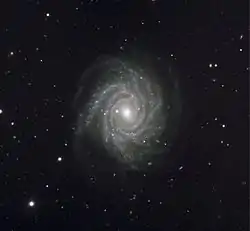| NGC 1288 | |
|---|---|
 Composite image of NGC 1288 taken with the Very Large Telescope. Supernova SN 2006dr is visible just to the left of the nucleus. | |
| Observation data (J2000 epoch) | |
| Constellation | Fornax |
| Right ascension | 03h 17m 13.176s[1] |
| Declination | –32° 34′ 33.08″[1] |
| Redshift | 0.01500[2] |
| Heliocentric radial velocity | 4,497[2] km/s |
| Distance | 196 Mly (60 Mpc)[3] |
| Characteristics | |
| Type | SABc(rs)[4] |
| Mass/Light ratio | 14[3] M☉/L☉ |
| Apparent size (V) | 2′.2 × 1′.8[5] |
| Other designations | |
| MCG -05-08-025, PGC 12204[6] | |
NGC 1288 is an intermediate barred spiral galaxy located about 196[3] million light years away in the constellation Fornax.[5] In the nineteenth century, English astronomer John Herschel described it as "very faint, large, round, very gradually little brighter middle." The morphological classification of SABc(rs)[4] indicates weak bar structure across the nucleus (SAB), an incomplete inner ring orbiting outside the bar (rs), and the multiple spiral arms are moderately wound (c).[7] The spiral arms branch at intervals of 120° at a radius of 30″ from the nucleus. The galaxy is most likely surrounded by a dark matter halo, giving it a mass-to-light ratio of 14 M☉/L☉.[3]
On July 17, 2006, a supernova with a magnitude of 16.1 was imaged in this galaxy from Pretoria, South Africa, at 12″ east and 2″ of the galactic core.[8] Designated SN 2006dr, it was determined to be a type Ia supernova.[9]
References
- 1 2 Skrutskie, Michael F.; Cutri, Roc M.; Stiening, Rae; Weinberg, Martin D.; Schneider, Stephen E.; Carpenter, John M.; Beichman, Charles A.; Capps, Richard W.; Chester, Thomas; Elias, Jonathan H.; Huchra, John P.; Liebert, James W.; Lonsdale, Carol J.; Monet, David G.; Price, Stephan; Seitzer, Patrick; Jarrett, Thomas H.; Kirkpatrick, J. Davy; Gizis, John E.; Howard, Elizabeth V.; Evans, Tracey E.; Fowler, John W.; Fullmer, Linda; Hurt, Robert L.; Light, Robert M.; Kopan, Eugene L.; Marsh, Kenneth A.; McCallon, Howard L.; Tam, Robert; Van Dyk, Schuyler D.; Wheelock, Sherry L. (1 February 2006). "The Two Micron All Sky Survey (2MASS)". The Astronomical Journal. 131 (2): 1163–1183. Bibcode:2006AJ....131.1163S. doi:10.1086/498708. ISSN 0004-6256. S2CID 18913331.
- 1 2 Jones, D. Heath; et al. (October 2009), "The 6dF Galaxy Survey: final redshift release (DR3) and southern large-scale structures", Monthly Notices of the Royal Astronomical Society, 399 (2): 683–698, arXiv:0903.5451, Bibcode:2009MNRAS.399..683J, doi:10.1111/j.1365-2966.2009.15338.x, S2CID 119223679.
- 1 2 3 4 Fuchs, B.; et al. (December 1999), "Quantitative interpretation of the morphology of NGC 1288", Astronomy and Astrophysics, 352: L36–L39, Bibcode:1999A&A...352L..36F.
- 1 2 D. A., Gadotti; et al. (September 2001), "Homogenization of the Stellar Population along Late-Type Spiral Galaxies", The Astronomical Journal, 122 (3): 1298–1318, arXiv:astro-ph/0106303, Bibcode:2001AJ....122.1298G, doi:10.1086/322126, S2CID 16376731.
- 1 2 Aranda, Ted (2012), 3,000 Deep-Sky Objects: An Annotated Catalogue, Patrick Moore's practical astronomy series, Springer, p. 107, ISBN 978-1441994196.
- ↑ "NGC 1288". SIMBAD. Centre de données astronomiques de Strasbourg. Retrieved 2021-02-19.
- ↑ Buta, Ronald J.; et al. (2007), Atlas of Galaxies, Cambridge University Press, pp. 13–17, ISBN 978-0521820486.
- ↑ Monard, L. A. G. (July 2006), D. W. E., Green (ed.), "Supernova 2006dr in NGC 1288", Central Bureau Electronic Telegrams, 578: 1, Bibcode:2006CBET..578....1M.
- ↑ B., Monard (June 2007), "Report on CCD activities at the Bronberg Observatory (CBA Pretoria) in 2006", Monthly Notes of the Astronomical Society of South Africa, 66 (5–6): 106–109, Bibcode:2007MNSSA..66..106M.
External links
 Media related to NGC 1288 at Wikimedia Commons
Media related to NGC 1288 at Wikimedia Commons- Nemiroff, R.; Bonnell, J., eds. (December 30, 1999). "The Century that Defined Galaxy". Astronomy Picture of the Day. NASA. Retrieved 2013-07-08.
- FORS1 First Light - Spiral galaxy NGC 1288, ESO, September 23, 1998, retrieved 2013-07-08.